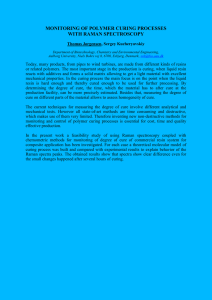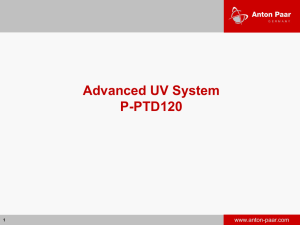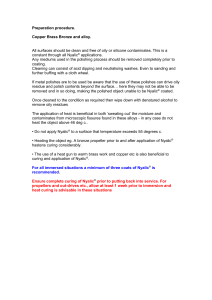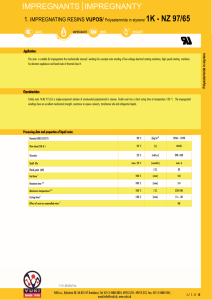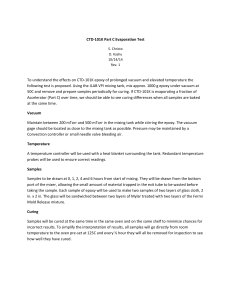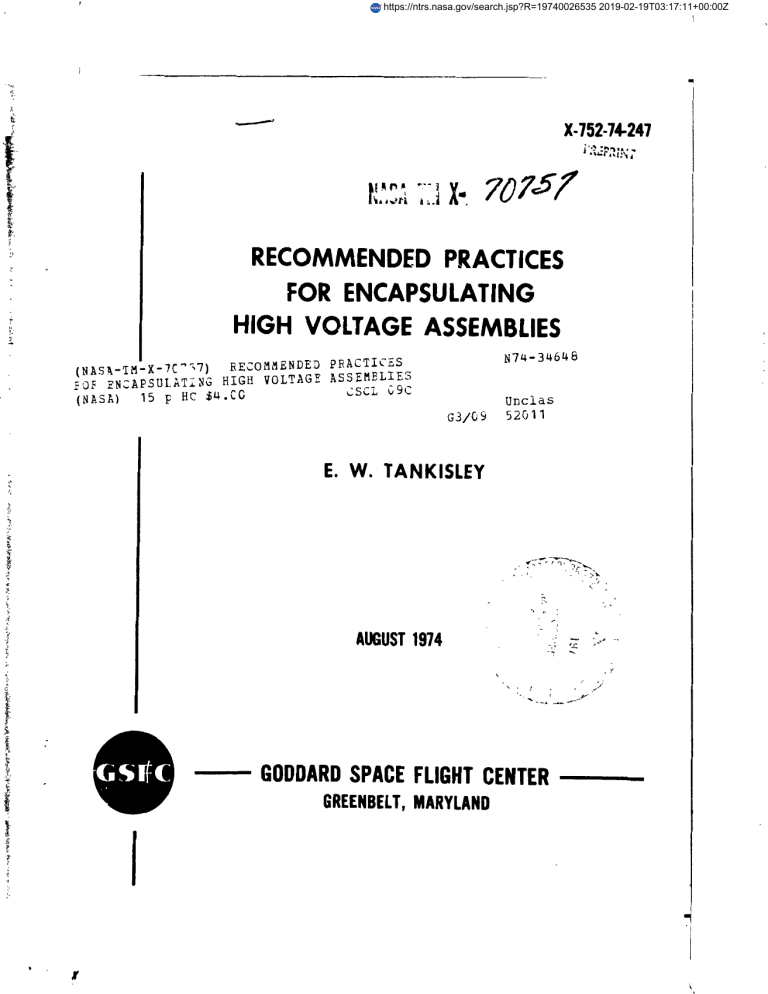
https://ntrs.nasa.gov/search.jsp?R=19740026535 2019-02-19T03:17:11+00:00Z RECOMMENDED PRACTICES FOR ENCAPSULATING HIGH VOLTAGE ASSEMBLIES I N74-34646 (NASl-lH-x-7C';7) RECOHEIENDE3 PRACTICES I06 2N;APSULATilG H i G H VOLTAGZ A S S E H E L I E S (NASA) 15 F HC b 4 . C C L S C t G 9C Unclas AUGUST 1974 GODDARD SPACE FLIGHT CENTER GREENBELT, MARY LAND RECOMMENDED PRACTICES FOR ENCAPSULATING HIGH VOLTAGE ASSEMBLIES E. W. Tankisley ENGINEERING SERVICES DNISION August 1974 GODDARD SPACE FLIGHT CENTER Greenbelt, Maryland RECOItIJIENDED PRACTICES FOR ENCX PSULATING HIGH VOLTAGE ASSEMBLSES E. W. Tankisley Engineering Services Division ABSTRACT The purpose of this document i s to give general instruction for preparation and encapsulation of high voltage assemblies. Related problems in encapsulating a r e brought out in these instructions. A test sampling of four frequzmtly used encapsulating compounds are shown in table form. The purpose of this table i s to give a general idea of the working time available and the s i z e of the container required for mixing and de-aerating. CONTENTS PROCEDURE........................................ 1 ..................... 1 2. Surface Preparation. ............................. 2 3. h e p a r i n g Encapsulating Material, .................... 2 4. Pouring Encapsulating Material and Vacuum Removal of Trapped Air ................................. 5. Curing ....................................... 8 CONCLUSION........,.... .......................... 8 ACKNOWLEDGEMENT.................... ............. 10 APPENDIX.. ....................................... 11 1. Cleanliness and Care in Handling ,) ILLUSTRATIONS Figure - 1 G75-01462 Self contained assembly with extension and sealing material. ....... ....... G75-01463 Gravity feeding of encapsulating material ...... contained assembly with small openings ............... G75-01470 Pauring in vacuum by mechanical means ...... G75-01473 Hand pouring to prevent air entrapment TABLE Table 1 Materials - Tfrne and Expansion Table ............... RECOMMENDED PRACTICES FOR ENCAPSULATING HIGH VOLTAGE ASSEMBLIES INTRODCCTION High voltage assemblies are encapsulated primarily to prevent corona and arcing. Encapsulants also add structural reinforcement, close off components from the environment, and help prevent mechanical dnmage during handling. Common causes of corona and arcing in encapsulated assemblies a r e trapped air around the components and air bubbles in the encapsulating material. These defects can be minimized by vacuum de-aerating the mixed encapsulating material and by pouring the material while under vacuum, An additional defect that can cause voltage breakdown i s lack of adhesion of the encapsulating material to the assembly. Adequate adhesion can be insured by proper cleaning or primary practices. PROCEDURE The following procedure describes practices employed by the Plastics Section, *@neeringServices Division, for eliminating voids and air bubbles in the enc, ~llatingmeterial. I. Cleaniixss and Care in Handling a. Provide clean work area and clean equipment. b. Inspect encapsulating materials to insure freedom from foreign matter. c. Check expiration date on dated materials. Outdated materials shall not be used. d. Cover electronic assembly when not in actual use. Handle assembly with care. c. Visually inspect assembly for broken solder connections and broken leads. 2. Surface Preparation a. Clean the assembly with 200-proof ethyl alcohol using clean stiff brush, or clean air stream. When cleaning with a liquid, let drain and air dry. Ultrasonic cleaning, sandblasting, or chemical etching should be used only with approval of Quality Assurance. b. If a silicone rubber polymer is used as the encapsulation material, all surfaces making contact with silicone shall be primed with manufacturers specified silicone primer. If the assembly is of an open design, it shall be dip-coated in primer. If it is a self-contained assembly, the primer shall be poured into the assembly and then poured off. Primer on surfaces where not wanted should be washed off immediately with 200-proof ethyl alcohol. Nost silicone rubber primers should air-dry one hour at ambient temperature. After the primer has dried, inspect assembly to make certain all component parts a r e primed, and if self-contained, all walls of the container primed; if not, prime again. NOTE: Never reuse primer! c. Inspect assembly container for leaks around leads, connectors, mounting holes and possible separations in container joints. Seal leaks with a material that will not contaminate or inhibit curing of encapsulating material, will hold up under heat of oven curing, and will be easily removed. (Example: Dow Corning R.T.V. 3116). (See Figure 1.) d. Extra height i s needed in assembly container to allow for expansion of encapsulating material under vacuum. Materials ior height extension a r e t o have the same requirements a s material in Step 2 (c). (See Figure 1.) e. If assembly is to be placed in a mold, and mold removed after curing, a suitable release agent is applied. Materials for molds and release agents a r e to have the same requirements as material in Step 2 (c). 3. Preparing Encapsulating Material a. M M n g container shall be clean, nonporous, a s polyethylene o r glass. 90 not use paper cups. Mixing instrument shall be a clean stainless steel spatula, o r clean glruss rod. Size of mixing container shall allow for expansion of encapsulating material under vacuum. (See Table 1). b. Using gram scales and allowing for weight of mixing container, weigh out required amount of resin, and add curing agent in proper ratio specified by manufacturer. Resin - lpart 10 parts 50 parts Resin 100 parts Curing agent 50 parts Resin Resin 50 parts Curing agent 50parts agent , Curing I Ratio of mix by weight Table 1 6 minutes 7 minutes 10 minutes rime to de-aerate after mixing 5 4 Volume Expansion in Vacuum (times original volume) - Time and Expansion Table Pot life Room temp. 35 min. 1 hr. 45 min. 6 hrs. 45 min ? hr. 20 min. Note 2: Pot life is measured from the time mixing is complete until the material begins to gel. Note 1: Test samples consisted of 1 cubic inch of material, mixed for 2 minutes. Filled Epoxy Stycast 3050 r e s i n Epoxy Epon 828 resin V-40 curing agent Resin and curing agent Preheated separately to 52C Polyurethane Solithane 113 resin C113-300 curing agent Resin and curing agent preheated separately to 52C Clear silicone rubber 93-500 resin 93-500 curing agent Material Materials Mix thoroughly, making certain that mixing instrument comes in contact with sides and bottom of mixing container, s o no unmixed materials remain. When a filler material is used, it shall be added only after resin and curing agent have been thoroughly mixed. Filler material i s added and mixed gradually and thoroughly with resin mix. Most polyurethane and some epoxy manufact .erls specifications call for heating resin and curing agent in separate containers before mixing, and also preheating the electronic assemblies when possible. These steps lower the viscosity, providing easier mixing and removal of trapped air. c. Notice should be taken of manufacturer's pot life of mixed material, as this could be a controlling factor for total time under vacuum. NOTE: With most mixed encapsulating materials, the largelathe volume, the shorter the pot life. (See Table 1). d. Place encapsulating materid in its mixing container under vacuum where visible (asa glass bell j a r ) , and begin pumping. If mixed material is of highly frothing nature and threatens to spill over mixing container, it will be necessary to partially vent the vacuum chamber, and begin pumping again. It may be necessary to repeat this several times. With most materials, after frothing has stopped and the material has collapsed, a few more minutes of pumping will provide sufficient de-aeration. (See Table 1). 4. Pouring Encapsulating Material and Vacuum Removal of Trapped Air a. When pouring encapsulating material by hand into assembly, pour in a manner a s to keep air bubbles to a minimum. Examples: Tip container on an angle and pour slowly down side of container (See Figure 2). When the assembly has no large openings, then mixed material is added by gravity feeding. Material is placed in a clean container with a tube attached that will f i t an opening. Suspend container u .th tube above assembly and allow to gravity-feed slowly. A second vent hole is required for escaping displaced gases. (See Figure 3). b. After mixed material has reached proper level in assembly, it is placed under vacuum and punped. Again, it may be necessary to vent the vacuum eystem several times, due to frothing action. Pumping is continued until all trapped air is removed, or when pot life ends (whichever takes place first). (See Table 1). c. \'acuum encapsulating is preferred for best results, when practical. When pouring under vacuum by mechanical meane, the electronic assembly ,and mixed encapsulating material a r e both laced in the vacuum chamber. The electronic assembly i s positioned s o that, when mechanically pouring, material will not overshoot asscmbly. Before pouring, pump for 1 5 minutes to remove a i r from assembly. After a i r i s removed from assembly, continue to pump, and commence to pour, slowly, into the assembly. Again, if a great m o u n t of frothing i s encountered, stop pouring; this alone may slow frothing actiofi. If not: partial. . vent the vacuum chamber. After encapsulating material has reached the proper level, pumping is continued until trapped a i r i s removed, o r when pot life ends (whichever t'akes place first), (See Figure -1). - 5. Curing a. Manufacturer's specified cure schedule shall be followed unless components cannot withstand the requir ed temperature; then, a revised cure schodulc is necessary. IJnless a room-temperature cure is specified, thc assembly should bz cured in a clean oven of the circulating Qpe. Oven temperature shall be controlled to plus o r minus 1 degree C. It should have a fail-safe override setting 5 degrees C above the preset lcvel. b. The oven shall be preheated to the specified cemyerature (or revised tempcraturc), 'and the assembly placed in the o w n in a lcvel pocit' c. After the curing time, the unit s h d l bc dlowcd to cool slow' to ‘ambient temperature (annealing shilosophy) . -1. 2 oven d. After rcn-.oval from the oven, dl sealing n ~ a t e r i a l sand added extensions a r e removed. The outside of unit shall be cleaned with ZOO-proof ethyl alcohol. e, Keep the assembly in a clean condition by proper storage, a s in a clean box or sealed polyethylene bag. CONCLUSION Many high voltage assemblies have been successfully encapsulated using this procedure. Modifications of the suggested practices a r e required in some instances; however, vacuum de-aeration of the encapsulating materials should be performed to insure a sound, bubble-free encapsulmt. When new o r unfamiliar encapsulating materials a r e to be used, a trial run should be performed to check the behavior of the mixed material under vacuum, to determine the time required for de-aeration, and to establish the pot life. ACKNOWLEDGEMENT The author wishes t o express his gratitude for the technical assistance of Mr. John L. Westrom, Space Power Technology Branch, Power Conversion and Control Sectior,. APPENDIX The following is a list of nncerials and their manufacturers referred to in this document. R. T. V. 3116 93-500 Silicone rubber 93-500 Curing Agent Dow C o r l h g ?. Midland, Michigar, Solithane 113 resin C113-300 Curing agent Thiokol Chemical Corp. Trenton, New Jersey Epon 828 resin V-40 Curing agent Miller-Stephenson Chemical Co. Danbury, Connecticut Stycast 3050 resin Catalyst - 9 Emerson and Cuming, Inc. Canton, Massachusetts
